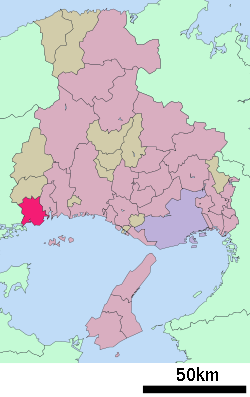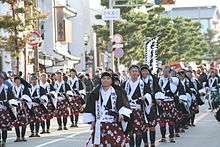Akō, Hyōgo
| Akō 赤穂市 | ||
|---|---|---|
| City | ||
| ||
 Location of Akō in Hyōgo Prefecture | ||
 Akō Location in Japan | ||
| Coordinates: 34°45′06″N 134°23′35″E / 34.75167°N 134.39306°ECoordinates: 34°45′06″N 134°23′35″E / 34.75167°N 134.39306°E | ||
| Country | Japan | |
| Region | Kansai | |
| Prefecture | Hyōgo Prefecture | |
| Government | ||
| • Mayor | Masaaki Mameta (since January 2003) | |
| Area | ||
| • Total | 126.88 km2 (48.99 sq mi) | |
| Population (April 30, 2011) | ||
| • Total | 50,902 | |
| • Density | 400/km2 (1,000/sq mi) | |
| Symbols | ||
| • Tree | Cherry blossom | |
| • Flower | Azalea | |
| Time zone | Japan Standard Time (UTC+9) | |
| City hall address |
Kariya 81, Ako City, Hyogo Prefecture (兵庫県赤穂市加里屋81) 678-0292 | |
| Website |
www | |



Akō (赤穂市 Akō-shi) is a city located in southwestern Hyōgo Prefecture, Japan.
As of April 30, 2011, the city has an estimated population of 50,902, with 19,841 households and a population density of 401.18 persons per km². The total area is 126.88 km².
The city was officially founded on September 1, 1951. The city faces the Inland Sea and salt production was its main industry during the feudal period. Other industries are fishery, and tourism thanks to a famous act of vengeance by the Forty-seven Ronin in 1703, featured in the Chushingura.
History
During the Edo period, Akō was a capital of Akō han. Akō was a small han of 50,000 koku but rich thanks to salt production. Akō salt is famous for its high quality. Among the former daimyo of Akō was Asano Naganori, the master of the Forty-seven Rōnin. In memory of the forty-seven ronin, who finally accomplished the vengeance against Kira Yoshihisa for their master after hardship on January 30, 1703 (December 14, Genroku 15), the city has held a festival (gishi sai) on December 14, every year in the last hundred years. On the day of the festival, all the elementary and middle schools in the city are off, and the students and pupils are encouraged to participate in one of the sports and art competitions including those in kendo, judo, and shodo, or one of the parades, including the one re-enacting the victory of the forty-seven ronin and another one exhibiting the cultural features of the Edo period, such as sankin kotai.
Akō's castle, originally built by the grandfather of Asano Naganori, Naganao, stands in the center of the city today.
Geography
The city is bordered with the following cities and towns:
- Aioi city
- Kamigori town
- Bizen city, Okayama prefecture
- Himeji city (sea border)
Chikusa river goes through the center of the city, providing the moat of Ako Castle with water through a branch, Kariya river. The central part of the city around the castle has been built on the alluvial plain of Chikusa river.
The city is on the border of the Hyogo and Okayama prefectures, which also divides the Kinki and Chugoku areas. On each side of the border, ancient Harima and Bizen provinces, which are now Ako and Bizen cities, respectively, have cultivated their own cultures. Therefore, even at the present days, dialects are vastly different on the sides of the border. A traveller from west to east on the JR San'yō Main Line will notice that the dialect of passengers suddenly changes between Kamigori station in Hyogo prefecture and Mitsuishi station in Okayama prefecture. In Ako, people speak a type of the Kansai dialect whose intonation is however of Tokyo type. The superset of the dialect spoken in Ako, called Banshu-ben, is known as one of the most harsh-sounding dialects.
Education
- The Akō Board of Education operates public elementary and middle schools.
- Akō High School is operated by Hyōgo Prefectural Board of Education.
- Kansai University of Social Welfare was founded in 1997 and has been operated by Kansai Konko Educational foundation.
Museums
- Akō Tabuchi Memorial Museum of Art (赤穂市立 田淵記念館) has on display a remarkable "Cha no yu (茶の湯)" exhibit.
- Ako city museum of history (赤穂市立歴史博物館) built at the site of former rice granary collects, investigates, and exhibits historical materials related to the city of Ako, especially through the forty-seven samurai and salt production.
Parks
- Ako Kaihin Koen (赤穂海浜公園) located on the east bank of the Chikusa river at its junction with Setonaikai is a complex of a facility which offers an experience of old-style salt production, camping sites, tennis courts, play grounds, ponds where rental boats are available, and a small zoo.
Things to buy
- Shiomi Manjū is a Japanese sweet. The outside shell is a little salty while the inside made of azuki paste is very sweet. It goes very well with (strong/bitter) green tea or coffee.
Sister City
External links
| Wikivoyage has a travel guide for Ako. |
 Media related to Akō, Hyōgo at Wikimedia Commons
Media related to Akō, Hyōgo at Wikimedia Commons- Akō City official website (Japanese)
- Akō City official website
- Akō Tabuchi Memorial Museum of Art official website (Japanese)